News & Articles
Browse all content by date.
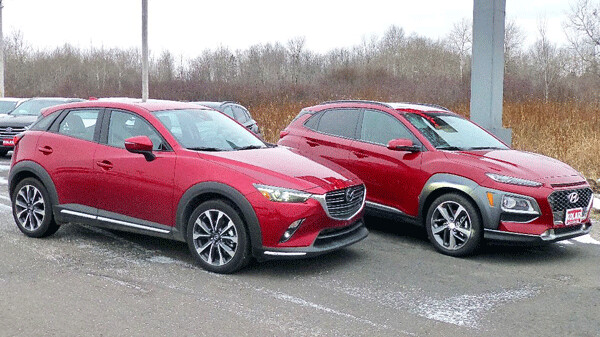
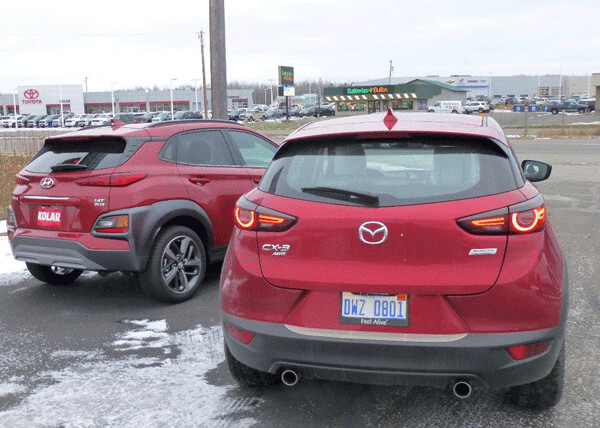
The model year changeover is extra intriguing this year because of the numerous and impressive bits of technology that have made their way into the automotive world. Here at Newcarpicks, we have whittled down the list of possible candidates for our Car of the Year down to the core, and the final decision will reflect the nation’s never-ending hunger for SUVs but will refuse to also recognize the seeming indifference to poor fuel economy that accompanies the quest for larer SUVs.
No, two of our finalists are more similar than different, and the second of those just arrived for a week-long examination in the Great White North. It is the Mazda CX-3 for 2019, which changes subtly from 2018 as a transitional vehicle in Mazda’s always-enticing lineup.
Gazing out at it in the early morning light at the Gilbert Compound on the North Shore of Lake Superior, I couldn’t take my eyes off it. It fairly glowed, like a large ruby, luring me to get out there and drive it. Somebody asked me what color it was, and I said I couldn’t remember the precise name, but it is a deep, lustrous red that goes right to your soul. Or at least my soul.
Then I examined the sticker to see if I could find the color.. There it was: “Soul Red Crystal” it said. Not bad. Maybe the fact I suggested the color went right through me to my soul was a tip. That color came out two years ago as a different and exclusive red on the CX-5, the midsize member of Mazda’s three SUVs. Last year it migrated to other models, where it will continue to be offered.
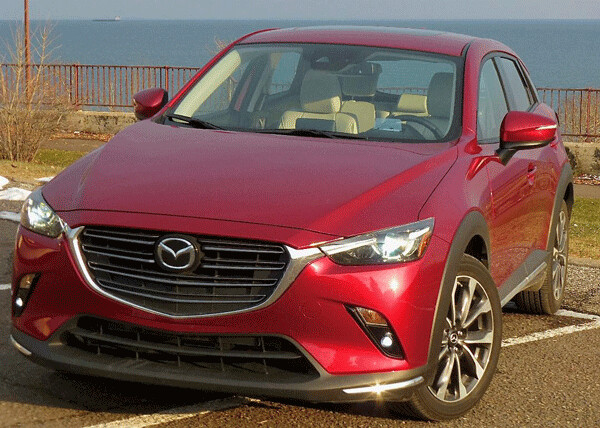
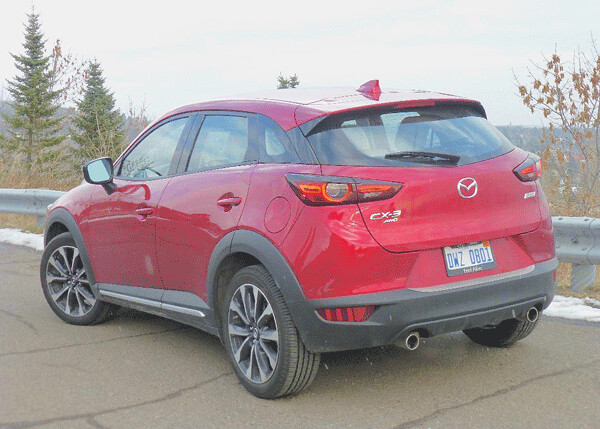
It turns out that Soul Red Crystal is a $595 option. I mentioned that to my inquisitive friend with the added note that it was a very expensive color, and probably worth it!
Seems outrageous, perhaps, but I have never seen another color on any car, regardless of price, that affected me the same as Soul Red. So how much is it worth to have a distinctive color that lifted you up every time you approached the vehicle.
The CX-3 is a small SUV, too small by many contemporary standards, but the reason it is one of our finalists is that is loaded up with technology to match or surpass any other SUV, and it has some tricks that are beyond all the others.
As one of our two award leaders coming around the final turn and heading down the homestretch, the CX-3 is opposed by the Hyundai Kona, the smallest SUV offering from that South Korean company, and it, too, comes loaded with technology that other low-priced SUVs can’t hope to challenge.
That, too, looks good in its vast array of colors, but the red one stands out. Together, the two look like later Christmas tree ornaments.
Ah, Christmas is drawing close, and those of us who have family members or close-enough friends deserving of a holiday gift — which includes about all of us! — might leave us baffled about what we could get them that would be really different. Unique, even.
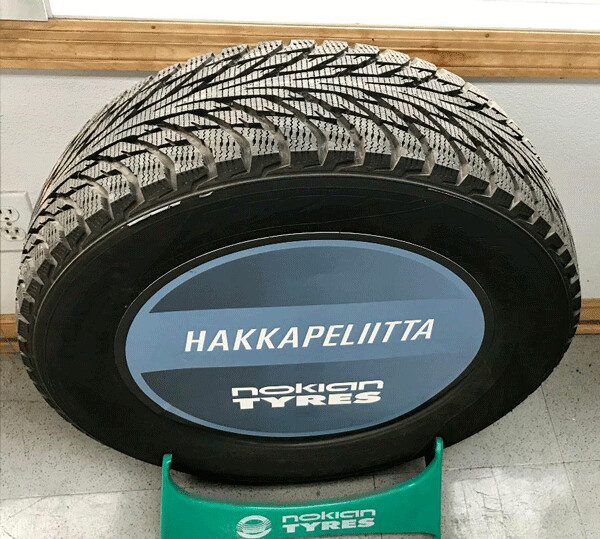
Buying a new vehicle for someone isn’t always possible, but if you need a new vehicle right about now, the CX-3 and the Kona are both available for right around $25,000, which is a modest price, especially when you examine the technology.
There are, of course, other wonderful Christmas gift ideas for a lot less than $25,000.
One is a set of winter or all-season tires, and the idea of the newest Nokian tires was appealing enough that I drove up to Ninth Street and Seventh Avenue East on the Duluth Hillside to talk to Jeff Hofstedt, propriator of “Foreign Affairs,” a cleverly named service outlet for all cars foreign or domestic, and also the nation’s leading seller of Nokian tires.
There are three or four different models of Nokians these days. I remain loyal to the all-season tires, stopping short of the all-out winter tire, the Hakkapeliitta. Without question, the Hakkapeliittas are the best winter tire on the market, matching the legendary Bridgestone Blizzak in glare-ice tracton, and outlasting even that stalwart for long wear in all conditions. I’ve found the WRG, and its newest derivative, the WRG-3, to be outstanding year-round, and still with exceptional snow and ice traction characteristics to get you through the harshest winter.
Both Car and Driver and Motor Trend finally got past the Tire Rack tradeout arrangement for using that company’s test track with the gentleman’s agreement deal that their annual winter tire test would only use winter tires sold at Tire Rack’s mail-order business. Nokian, a company in Finland which, Hoffstedt said, “invented the snow tire,” prefers to sell to smaller dealers and doesn’t go through Tire Rack, meaning Car and Driver and Motor Trend spent all those years comparing winter tires and declaring a winner while exclusing the best — the Nokian. The Hakkapeliitta won the top award by both magazines when they went to the company’s Finland home and tested above the Arctic Circle. I was hoping they’d include the WRG-3, because as an all-season tire, its unique tread compound sticks better than the snowtires of many competitors.
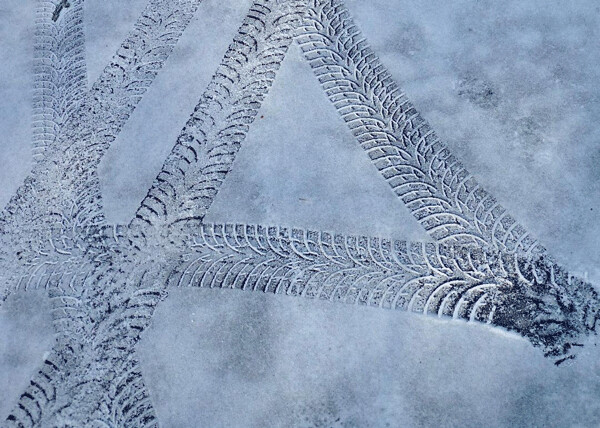
A set of Nokians might cost $500, but we have them on our car and our older son has them on his car in the Twin Cities. There is no better security for a parent than to know your spouse or child of any age is riding on tires that can conquer any winter weather without flinching. Or slipping.
The reason new tires came into my scope of consideration was that a friendly fellow who struck up a conversation with me asked when I might get back on KDAL radio, because he liked my show. I told him new management had other ideas, and he said he especially liked how I would explain things, after researching them, and added, “Now where can we go to find someone who will even tell us what kind of tires to buy?”
There. I’ve done that.

Another interesting new trend in gift ideas, especially in winter driving areas, is an intriguing idea Called AdventureStart by MyCharge, it is a device that is beyond handy and costs under $50. The company contacted me to see if I’d like to test one, and I assured them I would. They sent me a unit, and it comes with a plug-in pack that you charge up, then you stick it in your glove compartment, or trunk, and it has neat little pincer-like clamps that you can attach to the terminals of your dead battery. Give it a minute, hit the starter, and you are rescued.
My problem was that our car was in top shape and we never were threatened by a dead or dying battery at the end of last winter, so I was unable to give it a valid test. A good friend and his wife from Maryland bought a huge, used motorhome and headed west to visit relatives. He stopped by in Duluth, and parked his monster unit in our driveway. Somehow, a power switch got left on for 24 hours, and he found the vehicle’s battery too dead to start the engine.
“Wait!” I yelled. Then I ran to find the AdventureStart. We hooked it up, and after reconnecting, it allowed the big engine to fire up. If it could start thats thing, a normal car would be a cinch. Again, it’s an item that is a great piece of security for anyone living in an area that might be conducive to dead batteries.
Meanwhile, back to the Car of the Year candidates. In all the years I voted on the North American Car of the Year jury, I tended to apportion out my votes to favor styling, performance, and technology, with technology ranking highest, and performance including both speed and handling as well as fuel economy.
So doing the award separately for Newcarpicks.com, my opinions of what makes a car great haven’t changed. There are a lot of trucks and SUVs that are spacious and roomy and will tow heavy things, but falter when it comes to gas mileage. Gasoline prices are the lowest we’ve seen in a decade, but that doesn’t mean we should have a cavalier attitude and buy cars that get under 20 mile per gallon.
Similarly, we all are attracted to the gigantic service station signs that boas $2.45, meaning that’s the price of a gallon. But people buying and driving cars that require premium fuel are attracted to those signs, too, apparently without realizing they are giving the price of regular. Next time you buy gasoline, compare the price of regular and premium. Last time I did it, regular was $2.45 in Duluth, and premium at the same pump was $3.29. That’s a difference of 84 cents per gallon — and it doesn’t take much driving and tankfuls to realize how much worse you’re expenses are if you need premium.
Both our finalists — the Mazda CX-3 and the Hyundai Kona — have small but over-achieving engines. I reached mid-30 miles per gallon with both regularly, and topped 40 with the Kona and 42 with the CX-3.
The Kona has Hyundai’s 1.6-liter 4-cylinder with a turbocharger making it act like a bigger, stronger engine. The direct-sequential 7-speed transmission also extracted maximum efficiency.
The CX-3 had Mazda’s fantastic SkyActiv 2.0-liter 4-cylinder, although the 2.5-liter is also available. The test car I had happened to have the larger 2.5, while I greatly prefer the 2.0. The SkyActiv technology summons up all sorts of modern engine technology and has an extremely high 13-to-1 compression ratio, yet calls for regular fuel.
But here’s an interesting twist for 2019: Mazda is coming out with the SkyActiv-Plus version of the 2.0, and it will have 15-20 percent greater power, and greater fuel efficiency. It will be introduced on the Mazda3 compact sedan first, and while that car is getting totally redesigned for 2019, it also will offer all-wheel drive. That will plug in nicely to the CX-3.
But there’s more to the technology story than engine performance and fuel economy. The CX-3 has Mazda’s unique G-Vectoring control, which is truly amazing. It gives the car’s computer the authority to sense the first impulse that the driver is going to make a turn, and it instantly cuts the power to the outside front wheel and softens the suspension to the outside front, also for a millisecond. Together, those two things cause you as the driver to turn in at that moment, rather than possibly guessing and missing the apex even slightly. So instead of having to correct the steering, which is no big deal, but then running the risk of possibly over-correcting, which can be a big deal.
The CX-3 test vehicle didn’t explain any of that or give you that sort of complex feedback. All it did was track around corners with great precision, and you might not even notice that you never have to correct — or over-correct. I also has lane-departure warning, which tips you off if you have wandered to the lane line dividers left or right.
On the Kona, meanwhile, Hyundai has installed its lane-departure alert, and warningl, and goes beyond that to a lane-centering system that works so well you’ll think it’s voodoo. If you have it turned on to that extent, you go hard around a curve and the Kona will stay not only in its lane, but in the center of its lane.
So while both the CX-3 and Kona have such electronic gadgetry, both are aimed at driving ease but also safety that most drivers of car-buyers haven’t even comprehended yet.
You may need an SUV but not need a third-row seat. You may want, or need, an SUV for the security of its all-wheel drive. But if you don’t need the enormity of the large-SUV room, and you don’t need to carry five or six passengers over the river and through the woods to grandmother’s house, then a compact crossover SUV might be the perfect vehicle.
And both the CX-3 and Kona will give you the added bonus of precise steering, stay-in-your-lane stability, and mid-30s in miles per gallon.
Now, one of those vehicles, with Nokians mounted on all four corners and a portable charging device in the glove compartment, and your Christmas family trips will be a treat.
| Tweet |


